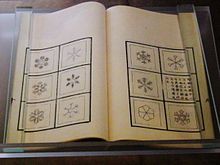Doi Toshitsura (土井 利位, June 15, 1789 – July 31, 1848) was a Japanese daimyō of the Edo period, who ruled the Koga Domain. He served as a rōjū for Tokugawa Ienari during the Tokugawa shogunate.[1]
Biography
Toshitsura was born in 1789. He was known to have a scholarly inclination and surrounded himself with individuals who were scholars, artists, and calligraphers.[2]
One of Toshitsura greater cultural legacies are the diagrams he made of 86 types of snowflakes that he catalogued in a book he titled the Sekka zusetsu, published in 1832.[3] He made his drawings by observing snowflakes with a Dutch microscope, and his drawings became popular among the artists of the time, who petitioned to see his work.[4][5] He would later expand his categories to 97 in 1840.[6] Toshitsura decision to bring his vassal Takami Senseki, a prominent retainer of the Koga Domain, to Nagaskiin 1836 resulted in the reproduction of a 'world map' which modern scholars have celebrated for relating trade routes and art of the time.[7]

In 1837 Toshitsura stopped a revolt led by Oshio Heihachirō, defending the castle of Osaka from Oshio's rebellion.[8]
Among the officials of the Bakufu, Toshitsura was one of the daimyō who were affected by the October 7, 1843 tempō reforms. Toshitsura, who was then a rōjū and held fiefs in Shimosa and Settsu, was in a position to have 13,000 koku of his Settsu holdings to be confiscated by the Bakufu. Despite his previous support for Tadakuni's reforms, this threatened to render him financially insolvent due to debts owed to his peasants. When he failed to negotiate a settlement with his peasants he instead attempted to oppose the Shogun's requests, a decision that rivals tried to pressure him with. Toshitsura would succeed though in getting the Shogun to halt his fief reformation plans.[9]
Toshitsura was succeeded by Abe Masahiro in his capacity as rōjū in 1845.[10] He died in 1848.[2]
Portrayal in Media
- Toshitsura character instigated the assassination against Matsudaira Naritsugu in the 1963 film 13 Assassins, where he was played by Tetsurō Tamba.[11]
- In the 2010 remake of the 1963 film, Toshitsura was played played by Mikijirō Hira.[12]
References
- ^ Bolitho, Harold (1974). Treasures among men: the fudai daimyo in Tokugawa Japan. New Haven: Yale University Press. ISBN 978-0-300-01655-0.
- ^ a b Jordan, Brenda G.; Weston, Victoria Louise (2003-01-01). Copying the Master and Stealing His Secrets: Talent and Training in Japanese Painting. University of Hawaii Press. ISBN 978-0-8248-2608-6.
- ^ Olovsson, Ivar (2016). Snow, Ice and Other Wonders of Water. World Scientific. ISBN 978-981-4749-37-4.
- ^ Hibi, Sadao; Niwa, Motoji (2001). Snow, Wave, Pine: Traditional Patterns in Japanese Design. Kodansha International. ISBN 978-4-7700-2689-7.
- ^ Gosnell, Mariana (2011-04-27). Ice: The Nature, the History, and the Uses of an Astonishing Substance. Knopf Doubleday Publishing Group. ISBN 978-0-307-79146-7.
- ^ Sturm, Matthew (2020-12-15). A Field Guide to Snow. University of Alaska Press. ISBN 978-1-60223-415-4.
- ^ Oka, Mihoko (2022-04-06). War and Trade in Maritime East Asia. Springer Nature. ISBN 978-981-16-7369-6.
- ^ Papinot, Edmond (1909). Historical and Geographical Dictionary of Japan: With 300 Illustrations, 18 Appendixes and Several Maps. Librairie Sansaisha.
- ^ Akamatsu, Paul (November 2010). Meiji 1868: Revolution and Counter-Revolution in Japan. Routledge. ISBN 978-1-136-92827-7.
- ^ McOmie, William (2021-11-15). The Opening of Japan, 1853–1855: A Comparative Study of the American, British, Dutch and Russian Naval Expedition to Compel the Tokugawa Shogunate to Conclude Treaties and Open Ports to Their Ships in the Years 1853-55. BRILL. ISBN 978-90-04-21362-3.
- ^ "13 Assassins (1963)". IMDb.
- ^ "13 Assassins". IMDB. 2010.








